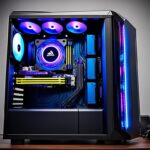Cloud gaming has revolutionized the way we play and experience video games. Gone are the days of needing a high-end gaming console or a powerful gaming PC. With cloud gaming, you can access a vast library of games and play them instantly on various devices, all without the need for expensive hardware.
However, as convenient as cloud gaming may be, it is not without its challenges. One of the most common issues faced by cloud gamers is game lag. Lag can hinder your gaming experience, causing delays, unresponsive controls, and frustrating gameplay.
Imagine this: You’re in the middle of an intense battle in your favorite online multiplayer game. Your character is about to deliver the final blow to the enemy, but suddenly, the game freezes for a split second. When it resumes, you find yourself defeated, and the victory slips through your fingers. This lag-induced defeat can be infuriating, and it’s a scenario that many cloud gamers have faced.
But fear not, there are steps you can take to make cloud gaming less laggy and enhance your streaming experience. By following these tips and optimizing your setup, you’ll be able to minimize lag and enjoy a smoother, more responsive gaming experience in the cloud.
Key Takeaways:
- Slow internet connection and high latency are common causes of game lag in cloud gaming.
- Optimizing router placement, closing extra games and apps, and using an ethernet cable can help improve your connection and reduce lag.
- Choosing the right browser and checking your network speed and bandwidth are also essential for a smoother gaming experience.
- Avoiding VPNs and network firewalls and optimizing QoS and router configurations are additional steps to minimize lag in cloud gaming.
- Implementing these tips will help you optimize your cloud gaming for low latency and enjoy a lag-free gaming experience.
Causes of Game Lag in Cloud Gaming
Game lag in cloud gaming can be frustrating and significantly impact your overall gaming experience. Understanding the causes of game lag is crucial for troubleshooting and improving your cloud gaming performance.
High Latency
One of the primary causes of game lag in cloud gaming is high latency. Latency refers to the time it takes for data to travel between your device and the game server. When latency is high, there is a delay in the transmission of data, resulting in laggy and unresponsive gameplay. Factors such as distance between your device and the server, as well as the quality of your internet connection, can contribute to higher latency.
Slow Internet Connection
A slow internet connection can significantly impact your cloud gaming experience. When your internet speed is insufficient, the data required for seamless gaming cannot be transmitted quickly enough, leading to game lag. Slow internet speeds can result from various factors, including network congestion, limited bandwidth, or using an outdated internet plan.
Network Interference
Interference from other devices in your home network can also contribute to game lag in cloud gaming. Devices such as smartphones, tablets, or smart home devices that use the same Wi-Fi network can consume bandwidth and affect the overall performance of your gaming connection. Additionally, physical barriers like walls or distance from the router can weaken the Wi-Fi signal and result in game lag.
Inadequate Hardware
Using hardware that is not optimized for cloud gaming can lead to game lag. Insufficient processing power, limited RAM, or an outdated graphics card can struggle to handle the demands of running cloud games smoothly. It is important to ensure that your device meets the recommended specifications for cloud gaming to minimize lag and enhance your gaming experience.
By addressing these causes of game lag, you can improve your cloud gaming performance and enjoy a smoother gameplay experience.
Recommended Router Placement for Better Connection

The placement of your internet router plays a crucial role in ensuring a smooth and uninterrupted gaming experience. Optimal router placement can improve your internet connection, reduce latency, and minimize lag. Here are some recommendations to help you optimize the placement of your router:
- Close proximity: Position your router as close to your gaming area as possible. This will help to minimize the distance data needs to travel, resulting in a stronger and faster connection.
- Reduce obstacles: Keep your router away from physical barriers such as walls, furniture, and appliances. These obstacles can interfere with the Wi-Fi signal and weaken the connection.
- Wi-Fi extender: If your gaming area is far from the router and you’re experiencing a weak signal, consider using a Wi-Fi extender or repeater. These devices can amplify the signal and extend the range of your Wi-Fi network.
- Gaming router: Invest in a router specifically designed for gaming. Gaming routers often come with advanced features like higher RAM, faster processors, and optimized firmware that can enhance your gaming experience.
By following these recommendations, you can optimize the placement of your router and improve your internet connection for gaming.
Comparison of Router Placement Options
| Router Placement Options | Pros | Cons |
|---|---|---|
| Close proximity to gaming area | Strong and fast connection | May not be feasible in all setups |
| Reduced obstacles | Minimized signal interference | May require rearranging furniture |
| Wi-Fi extender | Extended Wi-Fi range | Potential signal loss or latency |
| Gaming router | Advanced features for optimized performance | Higher cost compared to standard routers |
Choose the router placement option that best suits your gaming setup and enjoy an improved internet connection for an enhanced gaming experience.
Closing Extra Games and Apps for Improved Performance

When it comes to cloud gaming, optimizing your performance is essential for an immersive gaming experience. One effective way to achieve this is by closing any extra games and apps running in the background.
Running multiple games or applications simultaneously can consume unnecessary system resources, including RAM, and impact the performance of your cloud gaming session. By closing these extra tabs or applications, you can free up valuable internet bandwidth and ensure a smoother and more responsive gameplay experience.
Maximizing your internet bandwidth is crucial for cloud gaming as it heavily relies on a stable and high-speed connection. Closing extra games and apps helps alleviate the strain on your internet connection, allowing for improved data transfer rates and reduced latency.
To close extra games and apps, simply navigate to the task manager or application manager on your device and terminate any unnecessary processes. By doing so, you can optimize your internet bandwidth and focus system resources on delivering an exceptional cloud gaming performance.
Benefits of Closing Extra Games and Apps
- Optimize internet bandwidth by freeing up system resources
- Improve cloud gaming performance by reducing latency
- Enhance overall gameplay experience with smoother and more responsive gameplay
Tips for Closing Extra Games and Apps
| Step | Action |
|---|---|
| 1 | Access your device’s task manager or application manager |
| 2 | Identify unnecessary games and apps running in the background |
| 3 | Select the processes you want to close |
| 4 | Terminate the selected processes |
| 5 | Enjoy improved cloud gaming performance without the distractions of extra games and apps |
By following these steps and closing extra games and apps, you can optimize your internet bandwidth, reduce latency, and improve your cloud gaming performance. Take control of your gaming environment and enjoy a seamless and immersive gaming experience.
Using an Ethernet Cable for Faster Streaming
When it comes to cloud gaming, having a fast and reliable internet connection is crucial for a seamless and lag-free gaming experience. While Wi-Fi is convenient, it may not always provide the same level of stability and speed as a wired connection. That’s where using an Ethernet cable comes in.
An ethernet cable is a physical cable that connects your gaming device directly to your router or modem, bypassing the need for a wireless connection. By using an ethernet cable for gaming, you can reduce lag and enjoy faster streaming. Here’s how:
- Stability: Ethernet cables transmit data through a wired connection, which is inherently more stable compared to Wi-Fi. This stability helps reduce interruptions and latency, ensuring a smoother gaming experience.
- Speed: Ethernet cables provide faster data transfer speeds compared to Wi-Fi, allowing for quicker response times and minimizing lag. This is particularly beneficial for cloud gaming, where a high-speed connection is essential.
- Consistency: Unlike wireless connections, the performance of an ethernet cable is not affected by interference from other devices or obstacles like walls and furniture. This results in a more consistent and reliable gaming experience.
If your gaming device doesn’t have an ethernet port, you can still enjoy the benefits of a wired connection by using recommended ethernet dongles. These dongles connect to your device’s USB or Thunderbolt port and provide an ethernet port for a direct wired connection.
“Using an ethernet cable instead of relying on Wi-Fi can significantly improve your cloud gaming experience. Ethernet cables transmit data faster and experience fewer interruptions, leading to a more stable and responsive connection.”
Make sure to check the compatibility of the ethernet dongle with your specific device before purchasing. Additionally, ensure that the ethernet cable you use is of high quality to maximize performance.
| Advantages of Using an Ethernet Cable for Gaming | Disadvantages of Using an Ethernet Cable for Gaming |
|---|---|
| 1. Faster and more stable connection | 1. Limited mobility due to the need for a wired connection |
| 2. Reduced lag and latency | 2. Requires physical connection and cable management |
| 3. Consistent performance even with multiple devices connected | 3. Limited reach compared to Wi-Fi |
By using an ethernet cable for gaming, you can optimize your cloud gaming experience and enjoy reduced lag, improved responsiveness, and a more stable connection. Whether you’re a casual gamer or a competitive player, the advantages of a wired connection are hard to ignore.
Optimizing Browser Choice for Gaming

The browser you use for cloud gaming can significantly impact the quality of your streaming experience. Choosing the right browser can enhance graphics, optimize performance, and ensure a smoother gameplay experience. One browser that stands out in terms of gaming features and performance is Microsoft Edge.
Microsoft Edge: Enhancing Your Gaming Experience
Microsoft Edge offers several features that make it an excellent choice for cloud gaming. One standout feature is Clarity Boost, specifically designed to optimize the visual quality of Xbox Cloud Games. By enabling Clarity Boost in the browser settings, you can enhance graphics, making your gaming experience more immersive and enjoyable.
Additionally, Microsoft Edge has improved performance and speed, making it a reliable browser for cloud gaming. With faster loading times, reduced lag, and smoother gameplay, you can optimize your gaming experience and enjoy seamless streaming.
It’s worth noting that Microsoft Edge is not the only browser optimized for gaming. Other popular options include Google Chrome and Mozilla Firefox. These browsers also offer performance improvements and extensions that can enhance your gaming experience.
Choosing the right browser is crucial for an optimized cloud gaming experience. Microsoft Edge, with its Clarity Boost feature, can enhance graphics and overall performance, making it a top choice for gamers. However, it’s important to explore different browsers and find the one that suits your specific gaming needs.
Checking Network Speed and Bandwidth for Better Performance

When it comes to cloud gaming, having a fast and reliable internet connection is crucial for optimal performance. If you’re experiencing game lag or poor streaming quality, it may be time to check your network speed and optimize your bandwidth. Here are a few steps you can take to improve your gaming experience:
1. Run a Network Test
Running a network test can provide valuable insights into your internet speed and bandwidth. Many cloud gaming platforms offer built-in network tests that assess your network performance and provide recommendations for improvement. By analyzing the test results, you can identify any issues that may be causing game lag and take appropriate actions to address them.
2. Upgrade Your Internet Service
If you find that your internet speed is consistently below the recommended requirements for cloud gaming, consider upgrading your internet service. Choosing a higher download speed can ensure smoother gameplay and reduce latency. Contact your internet service provider to discuss available options for faster internet speeds.
3. Limit Network Traffic
While gaming, it’s essential to limit other network activities that may consume your available bandwidth. Streaming videos, downloading large files, or having multiple devices connected to the same network can slow down your connection and cause game lag. Prioritize your gaming experience by minimizing other network traffic during your gaming sessions.
4. Optimize Router Settings
Adjusting certain router settings can also help improve your network speed and bandwidth for cloud gaming. Consider enabling Quality of Service (QoS) settings on your router to prioritize gaming traffic. QoS ensures that your gaming data gets preferential treatment over other internet activities, resulting in reduced lag and smoother gameplay.
5. Use a Wired Connection
While Wi-Fi offers convenience, a wired connection can often provide a more stable and reliable gaming experience. Using an Ethernet cable to connect your gaming device directly to the router can minimize packet loss and reduce latency. If your device lacks an Ethernet port, consider using recommended Ethernet dongles for a wired connection.
6. Consider Wi-Fi Optimization
If you prefer using Wi-Fi for cloud gaming, optimizing your Wi-Fi signal can help enhance your gaming performance. Position your router closer to your gaming area to minimize signal interference and improve signal strength. Additionally, use Wi-Fi analyzer apps to identify the best Wi-Fi channel with the least interference.
| Network Speed | Minimum Requirement for Cloud Gaming | Recommended for Smooth Gameplay |
|---|---|---|
| Download Speed | 10 Mbps | 25 Mbps or higher |
| Upload Speed | 3 Mbps | 5 Mbps or higher |
| Latency (Ping) | Less than 50 ms | Less than 20 ms |
By following these steps and optimizing your network speed and bandwidth, you can significantly improve your cloud gaming experience. Enjoy immersive gameplay without the frustrating interruptions of game lag. Remember to regularly check your network performance to ensure the best possible gaming performance.
Optimize Wi-Fi for Cloud Gaming
When it comes to cloud gaming, having a strong Wi-Fi signal is crucial for a seamless and lag-free experience. To optimize your Wi-Fi connection for gaming, follow these steps:
- Choose a 5GHz Wi-Fi connection: The 5GHz frequency offers faster speeds and lower interference compared to the 2.4GHz frequency. Most modern routers support the 5GHz band, so make sure to select this option for your gaming needs.
- Position your router strategically: Place your router in a centralized location, preferably closer to your gaming area. This helps minimize signal loss and maximizes signal strength, resulting in a more stable connection.
- Minimize interference: Reduce interference from other electronic devices by placing your router away from appliances, cordless phones, and other Wi-Fi devices. This can help improve Wi-Fi signal strength and reduce latency.
- Use a Wi-Fi analyzer app: Wi-Fi analyzer apps can provide insight into the signal strength and channel congestion in your area. By analyzing the Wi-Fi networks around you, you can select the least congested channel for your router, optimizing your Wi-Fi signal for gaming.
By optimizing your Wi-Fi for gaming, you can reduce latency and improve the overall performance of your cloud gaming. Keep in mind that a wired connection, such as using an ethernet cable, can offer even better performance if feasible.
| Pros of 5GHz Wi-Fi | Cons of 5GHz Wi-Fi |
|---|---|
| Faster speeds | Shorter range |
| Lower interference | Less compatibility with older devices |
| Supports more simultaneous connections | Slightly higher cost for compatible routers |
Avoiding VPNs and Network Firewalls
While VPNs (Virtual Private Networks) and network firewalls offer security benefits, they can have a negative impact on gaming performance. When it comes to cloud gaming, it’s crucial to optimize your gaming experience by disabling VPNs and network firewalls.
VPNs are commonly used to secure internet connections and protect privacy. However, they can introduce additional latency, leading to lag and unresponsive gameplay. By disabling VPNs, you can establish a direct connection between your device and the game server, minimizing delays and ensuring a smoother gaming experience.
Similarly, network firewalls, which are designed to block unauthorized access, can interfere with the direct connection required for cloud gaming. Disabling network firewalls while gaming allows your device to communicate directly with the game server, reducing potential latency issues.
By avoiding VPNs and network firewalls, you can optimize your gaming experience and minimize lag in cloud gaming. Remember to toggle these security measures off before diving into your favorite games, ensuring a seamless and responsive gaming session.
QoS and Router Configuration for Gaming
When it comes to optimizing your gaming experience, understanding the intricacies of Quality of Service (QoS) settings and router configuration is essential. QoS settings on your router can prioritize gaming traffic, ensuring a seamless and uninterrupted gameplay session. By customizing these settings, you can improve the overall performance of your gaming sessions and reduce latency.
The first step is to check if your router supports QoS. Most modern routers have this feature, but it’s always best to consult your router’s technical support page or user manual for specific instructions. Once you’ve confirmed QoS support, you can proceed to customize the settings to prioritize gaming.
In addition to QoS settings, configuring your router to allow traffic on specific ports used by cloud gaming services is crucial. This optimization ensures that your connection is tailored to the requirements of cloud gaming, resulting in optimal streaming quality and reduced lag. For comprehensive guidance on configuring QoS and port forwarding, refer to your router’s technical support page or consult their customer service for assistance.
By harnessing the power of QoS and optimizing your router configuration, you can unlock the full potential of your gaming setup. Enjoy enhanced gaming performance, minimal lag, and an immersive gaming experience with these parameter adjustments.



